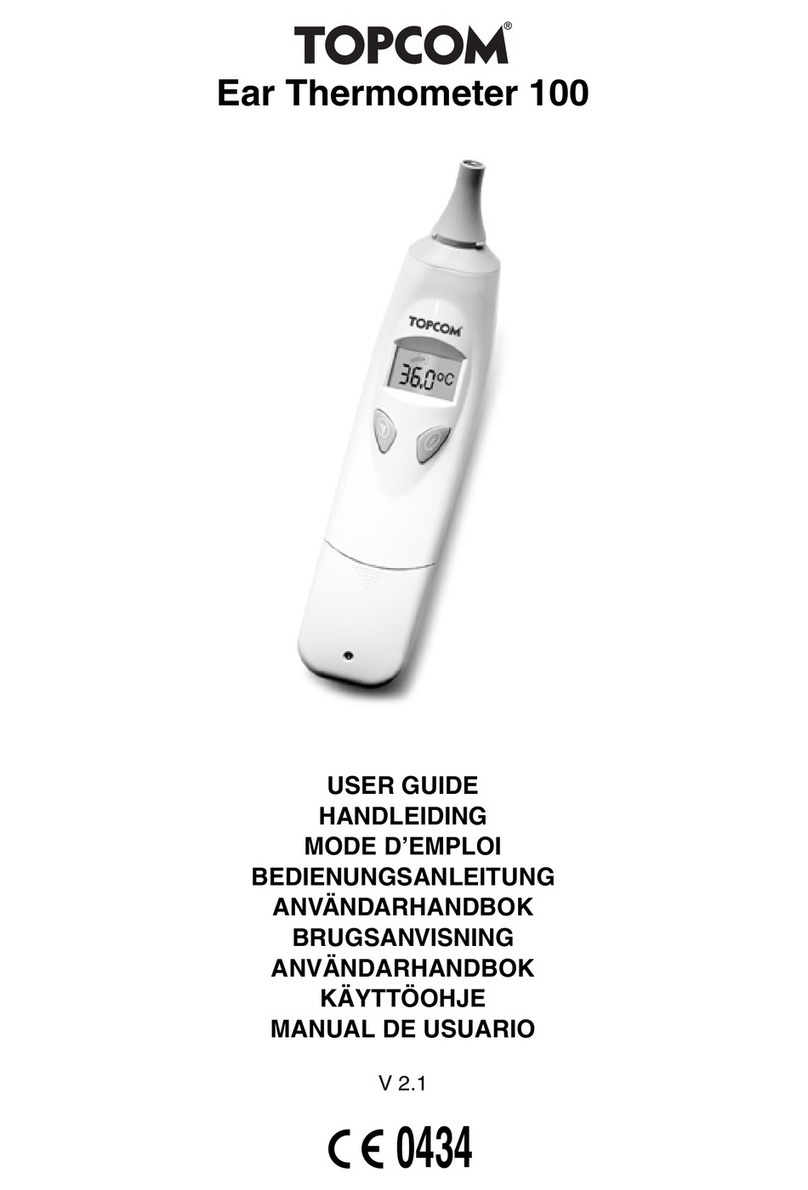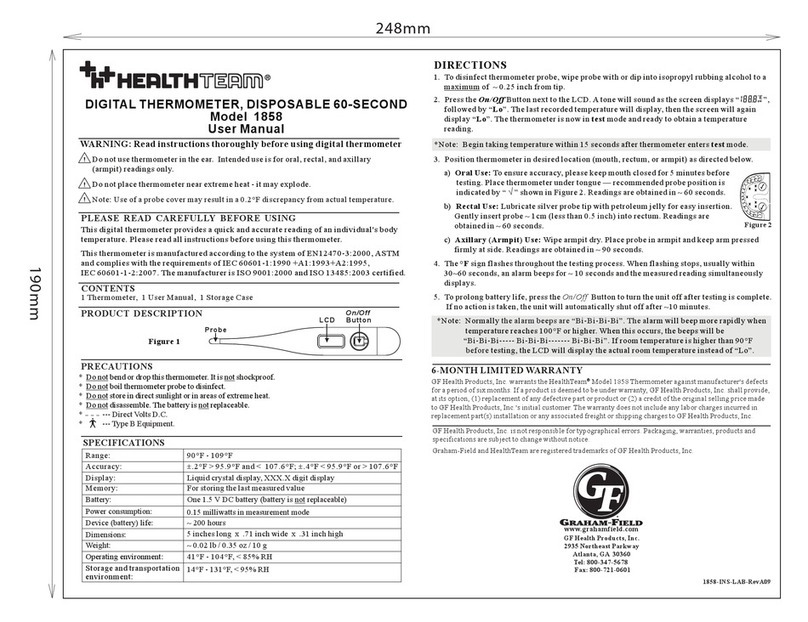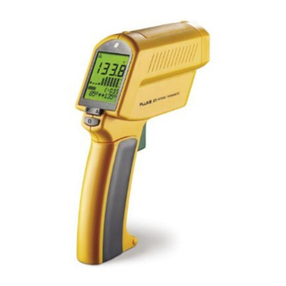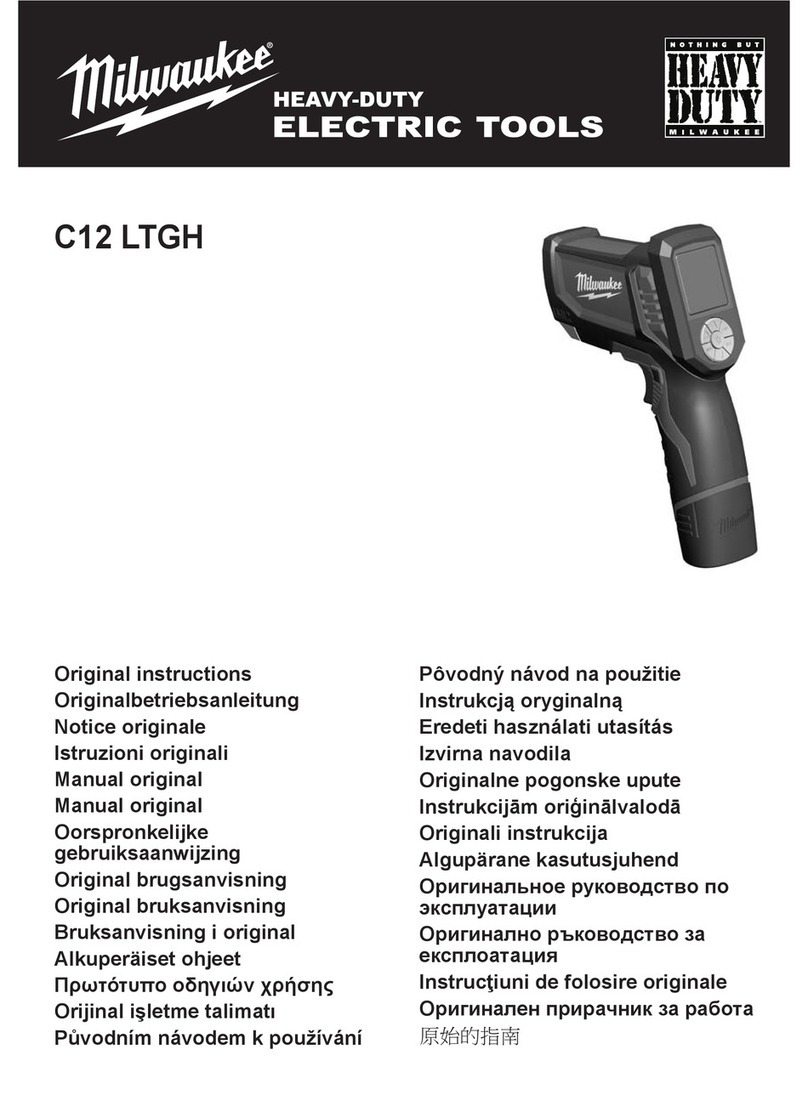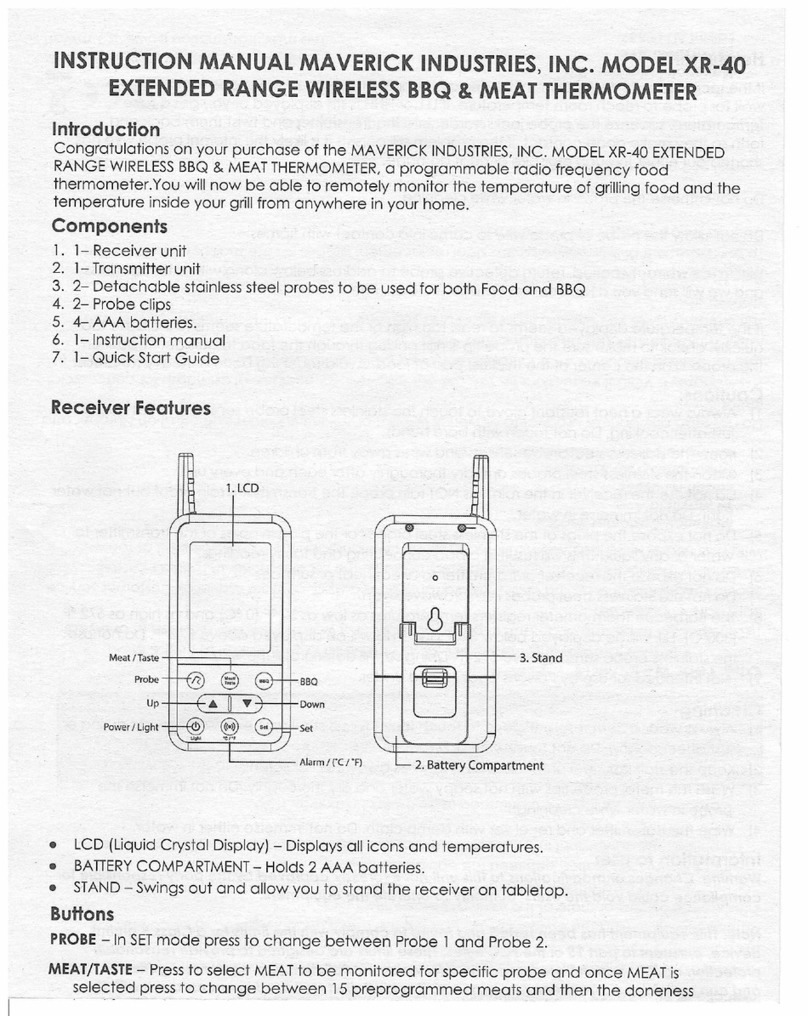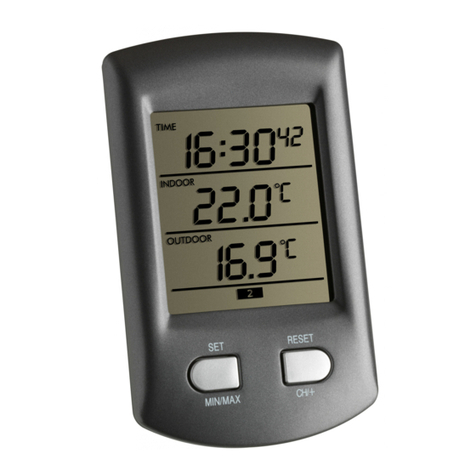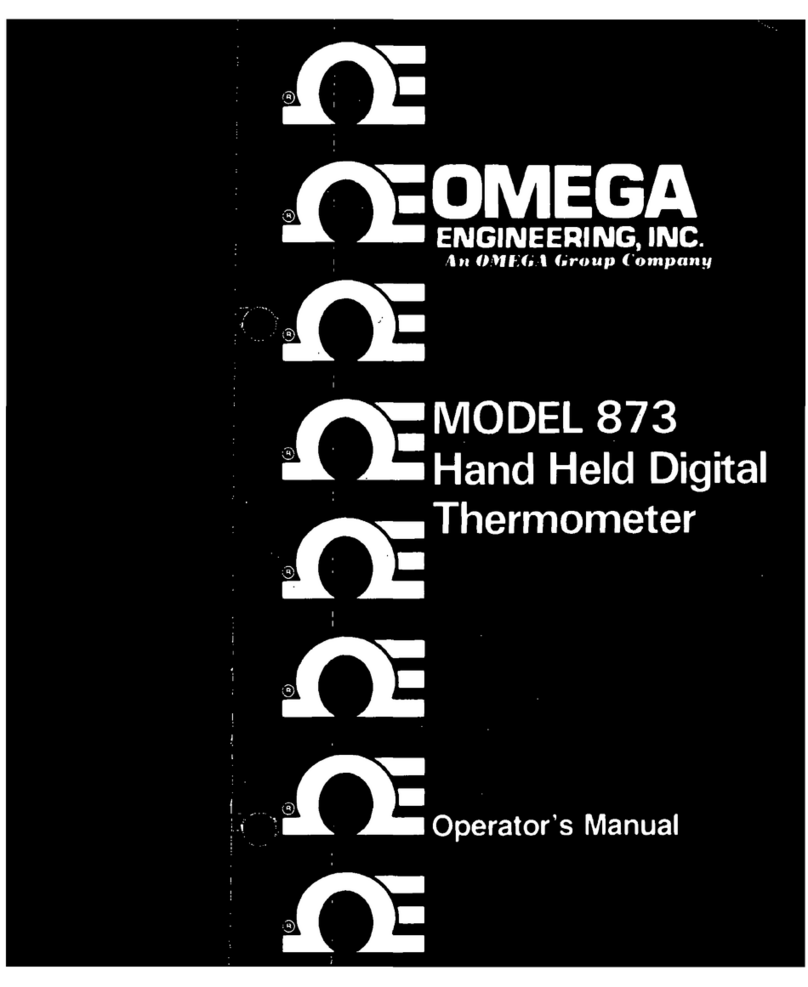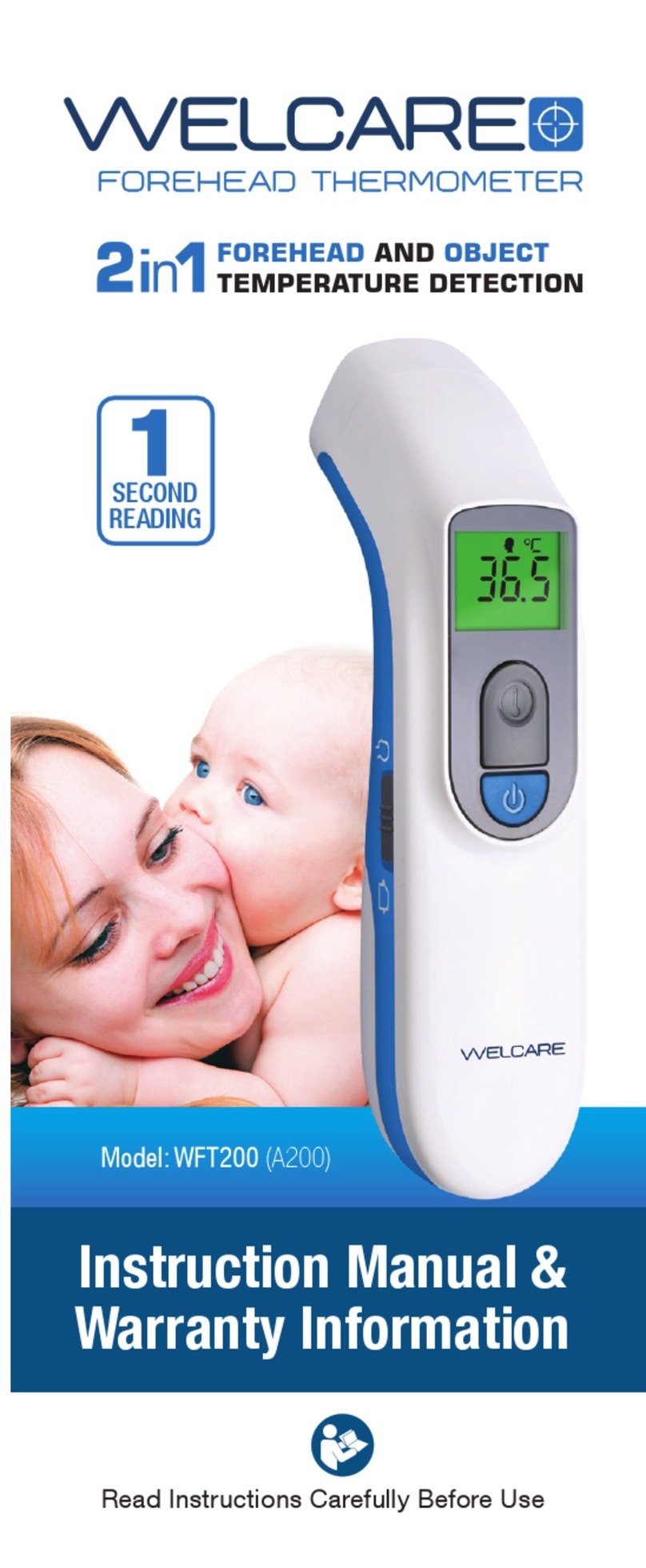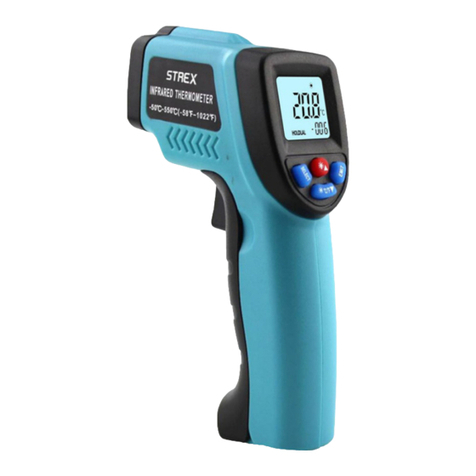Hans Dinslage Sanitas SFT 65 User manual

SFT 65
Service-Adresse:
Hans Dinslage GmbH,
Riedlinger Str. 28,
88524 Uttenweiler, GERMANY
Tel.: +49 (0) 73 74 / 91 57 66,
E-mail: [email protected]
D
MULTIFUNKTIONS-THERMOMETER
Gebrauchsanweisung....................... 2–17
G
MULTI-FUNCTION THERMOMETER
Instructions for use ........................18–31
F
THERMOMÈTRE MULTIFONCTION
Mode d’emploi ................................32–45
I
TERMOMETRO MULTIFUNZIONE
Istruzioni per l’uso ..........................46–59
r
МНОГОФУНКЦИОНАЛЬНЫЙ
ТЕРМОМЕТР
Инструкция по применению........ 60–75
ELECTROMAGNETIC COMPATIBILITY
INFORMATION ..............................................76–79
0483

18
Included in delivery
• Thermometer
• 2 x 1.5V AAA batteries, LR03
• These Instructions for Use
Please read through these Instructions for Use carefully and retain them for future reference; make them available to
other users and observe the information they contain.
1 Signs and symbols
The following symbols appear in these instructions.
Warning Warning instruction indicating a risk of injury or damage to health.
Important Safety note indicating possible damage to the unit/accessory.
Note Note on important information.
English
Contents
1 Signs and symbols ................................................18
2 Tips ........................................................................ 19
3 Device description ................................................. 21
4 Getting started....................................................... 22
5 Setting the device.................................................. 22
6 What you should know about using this
thermometer .......................................................... 23
7 Measuring .............................................................. 24
8 Replacing the battery............................................. 27
9 Storage and maintenance...................................... 28
10 Disposal ................................................................. 29
11 Technical data ....................................................... 29
12 Trouble-shooting.................................................... 31

19
2 Tips
Safety tips
Warning:
• To measure temperature, insert the sensor tip of the thermometer carefully into the ear.
• Use of the thermometer on dierent persons can be inappropriate in the event of certain acute infectious
diseases because of the possible spread of germs despite cleaning and disinfection. If you have any doubts,
please consult your doctor.
Notes on handling batteries
Warning:
• Batteries can be extremely dangerous if swallowed. Keep batteries out of the reach of small children. Should
a battery be swallowed, seek medical assistance immediately.
• Batteries must not be recharged or reactivated by any other means, taken apart, thrown into an open fire or
short circuited.
• Batteries can contain toxins that are harmful to health and the environment. Always dispose of batteries in
accordance with applicable legal regulations. Do not dispose of batteries with the normal household waste.
Important
• Replace weak batteries before they discharge completely.
• Leaking batteries can damage the device. If you do not use the device for an extended period of time,
remove the batteries from the battery compartment.
• Leaking batteries may damage the device. If you do not intend to use the device for longer periods, remove
the batteries from the battery compartment.

20
General advice
• Please read through these Instructions for Use carefully and retain them for future reference; make them
available to other users and observe the information they contain.
• This thermometer is a sensitive electronic device. Handle it with care and do not subject it to any mechanical
impacts.
• Do not expose the device to direct sunlight.
• Check before each use that the lens is intact. If it is damaged, please contact your retailer or the service
address.
• The thermometer is NOT waterproof. For this reason, direct contact with water or other liquids should be
avoided.
• This device ist not intended for commercial or clinical use.
• The SFT 65 thermometer is only designed for the measuring area on the human body stated in the instruc-
tions for use.
• The device is only intended for the purpose stated in these Instructions for Use.
• After each use, clean the measuring tip with a soft cloth moistened with disinfectant.
• The thermometer has been designed for practical use, but is not a substitute for a visit to the doctor.
• Before each repair query, first check the batteries and replace them if necessary.
• Repairs must only be carried out by authorised service centres, otherwise the guarantee is invalidated.
• This device complies with the EU Directive 93/42/EC concerning medical products, the Medizinprodukte-
gesetz (German Medical Devices Act), the ASTM (American Society for Testing and Materials) E 1965-98
and the European Standard EN 12470-5: Clinical thermometers – Part 5: Requirements for infrared ear
thermometers (with maximum device) and the European Standard EN60601-1-2, and is subject to particular
precautions with regard to electromagnetic compatibility. Please note that portable and mobile HF communi-
cation systems may interfere with this unit. More details can be requested from the stated Customer Service
address or found at the end of the instructions for use.
• If you should have any questions about using our devices, please contact either your retailer or Customer
Services.


22
4 Getting started
The batteries are already inserted in all new devices. Before first use, remove the protruding plastic insulating strip from
the battery compartment. The thermometer will then switch on automatically.
5 Setting the device
Set the unit in which the temperature will be displayed, the date and the time
Press the button for 1 second to switch the thermometer on. The device performs
a brief self test: all elements of the display are shown for approx. 1second. Following
a successful self test, the device emits two short beeps. In Standby mode, the date
and time are shown and “ ” is displayed.
When the thermometer is used for the first time, and each time the batteries are changed, the date and time are dis-
played in the format during the basic set-up (after the self test). Now set the unit in which the temperature will
be displayed, the date and the time. To set the device, proceed in stages: unit – year – month – day – hours – minutes.
• Press the button for approx. 3 second to access the Set mode.
The setting to be changed will flash in turn.
• Press the button again to save the setting or
• press the button to change the setting.
• Then press the button to save the setting.
After this process, the thermometer shows the word in the display and switches o automatically.

23
6 What you should know about using this thermometer
There are dierent thermometers for taking temperature measurements in dierent parts of the body:
• Ear/forehead thermometer (this thermometer, for measuring in the ear or on the forehead area)
• Rod thermometer (for rectal (in the back passage), axillary (under the arm) or oral measurement (in the mouth))
Taking the temperature gives a measurement that provides information about a person’s current body tempera-
ture. If you are uncertain about interpreting the results or if the value is abnormal, please consult your doctor.
This also applies in the case of slight temperature changes if there are other symptoms of illness such as agita-
tion, severe sweating, flushed skin, fast pulse rate, tendency to collapse etc.
Temperatures measured with dierent thermometers cannot be compared with one another. You should there-
fore tell your doctor (or bear in mind if you are diagnosing yourself) what thermometer you used to take your
temperature and in what part of the body.
The temperature of a healthy person is aected by various factors: the person’s individual metabolism, their age
(body temperature is higher in babies and toddlers and decreases with age. Greater temperature fluctuations
occur faster and more often in children, e.g. due to growth spurts), their clothing, the ambient temperature, the
time of day (body temperature is lower in the morning and increases throughout the day towards evening), the
preceding physical and, to a lesser extent, mental activity.
The temperature varies depending on the part of the body where the measurement is taken. The dierence can
be between 0.4°F (0,2°F) and 1.8°F (1°C) for a healthy body. The normal temperature ranges are as follows:
• On the forehead: 96.4°F – 99.7°F (35.8°C – 37.6°C), measured with a forehead thermometer
• In the ear: 96.8°F – 100°F (36.0°C – 37.8°C), measured with an ear thermometer
• In the back passage: 97.3°F – 100°F (36.3°C – 37.8°C), measured with a conventional thermometer
• In the mouth: 96.8°F – 99.3°F (36.0°C – 37.4°C), measured with a conventional thermometer
In order to track temperature change, always take the measurements in the same part of the body.

24
7 Measuring
Before each use, please check that the lens is intact. If it is damaged, please contact your retailer or the service address.
Bear in mind that the thermometer needs to have been in the room in which the measurement is taken for at least
30 minutes before use.
Measuring body temperature in the ear
• Some people produce dierent readings in their left and right ear. In order to record temperature changes,
always measure a person’s temperature in the same ear.
• The ear thermometer may be used by children only under adult supervision. Measurement is usually possible
over the age of 6 months. In infants under 6 months, the ear canal is still very narrow so the temperature of
the eardrum often cannot be recorded and the result displayed is often too low.
• The measurement must not be taken in an ear aected by inflammatory diseases (e.g. discharging pus or
secretion), after possible ear injuries (e.g. eardrum damage) or in the healing period after operative proce-
dures. In all of these cases, please consult your doctor.
• Use of the thermometer on dierent persons can be inappropriate in the event of certain acute infectious
diseases because of the possible spread of germs despite cleaning and disinfection. If you have any doubts,
please consult your doctor.
• This thermometer may only be used without a disposable protective cover.
• If you have been lying on one ear for some time, the temperature is slightly raised. Wait a little while or meas-
ure in the other ear.
• As ear wax can aect the measurement, you should clean the ear before measuring if necessary.



27
The temperature last measured, i.e. only the last value of a series of measurements, is automatically stored as soon as
the thermometer switches itself o or is switched o. There are 10 memory spaces available for this.
To switch the thermometer o, press the and buttons simultaneously for approx. 3 seconds.
If you do not press any other buttons, the thermometer automatically switches o approx. one minute after displaying
the measured value.
To call up the saved values, switch the thermometer on and press the button.
The date, time, storage space number, the measurement mode symbol and the temperature are displayed in turn.
Browse through the stored measurements by pressing the button repeatedly.
8 Replacing the battery
When the batteries get weak, the battery warning symbol appears . It is still possible to measure temperature. The
batteries must be replaced. When the battery symbol flashes and appears in the display, the batteries must be
replaced. If the batteries are too flat, then the thermometer will switch o automatically.
Note:
• When changing the batteries, use batteries of the same type, make and capacity.
• Always replace all batteries at the same time.
• Do not use rechargeable batteries.
• Use batteries free from heavy metals.


29
10 Disposal
Batteries should not be placed in the normal household waste.
As a consumer, you are required by law to recycle used batteries. You can recycle your old batteries at public collection
points in your community or wherever the same batteries are sold.
Observe the local regulations for material disposal.
Note:
The codes below are printed on batteries containing harmful substances:
Pb = Battery contains lead,
Cd = Battery contains cadmium,
Hg = Battery contains mercury.
Dispose of the unit in accordance with EC Directive 2002/96/EC – WEEE (Waste Electrical and Electronic
Equipment).
If you have any questions, please contact the local authorities responsible for waste disposal.
11 Technical data
Tip: If the device is used other than in accordance with the specifications, perfect functioning cannot be guaranteed. We
reserve the right to make technical changes to improve and develop the product.
The accuracy of this thermometer has been carefully checked and developed with regard to a long useful life.
If using the device for commercial medical purposes, it must be regularly tested for accuracy by appropriate means.
Precise instructions for checking accuracy may be requested from the service address.

30
Name and model SFT65
Measurement range Ear/Forehead thermometer mode: 93.2°F – 109.4°F (34°C – 43°C)
Object temperature mode: 32°F – 212°F (0°C – 100 °C)
Laboratory
measurement precision Ear thermometer mode: ±0.4°F (±0.2°C) from 95.9°F – 107.6°F (35.5°C – 42°C),
outside of this measurement range ±0.5°F (±0.3°C)
Forehead thermometer mode: ±0.5°F (±0.3°C) from 93,2°F – 109,4°F (34°C – 43°C)
Object temperature mode: ±2.7°F (±1.5°C) at < 86°F (<30 °C); ±5% at ≥ 86°F (≥ 30°C)
Interval between
2measurements At least 5 seconds
Clinical repeat precision Ear: Children, 1–5 years: ±0.14°F (±0.08°C)
Adults: ±0.13°F (±0.07°C)
Forehead: Children, 1–5 years: ±0.13°F (±0.07°C)
Adults: ±0.14°F (±0.08°C)
Measurement units °Celsius (°C) or °Fahrenheit (°F)
Ambient operating
conditions 60.8°F – 95°F (16°C – 35°C) with a relative humidity of up to 85% (non-condensing)
Storage conditions -13°F to 131°F (-25 °C to 55°C) with a relative humidity of up to 85% (non-condensing)
Dimensions 38.2 x 138 x 46.5 mm
Weight 90 g including battery
Battery 2 x 1,5V AAA (LR03)
Memory For 10 measurements

Table of contents
